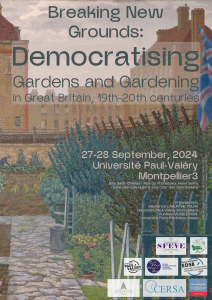 Colloque international : « Breaking New Grounds: Democratising Gardens and Gardening in Great Britain, 19th-20th centuries » (Montpellier, 27-28 septembre 2024)
Colloque international : « Breaking New Grounds: Democratising Gardens and Gardening in Great Britain, 19th-20th centuries » (Montpellier, 27-28 septembre 2024)
27-28 September, 2024
Université Paul-Valéry Montpellier3,
Site Saint-Charles – Rue du Professeur Henri Serre
Salle des colloques 2 / Cour des marronniers
A two-day conference organised by Clémence Laburthe-Tolra (Université Paul-Valéry Montpellier 3, EMMA) and Aurélien Wasilewski (Law & Humanities, CERSA, UMR 7106, Université Paris-Panthéon-Assas).
This conference stems from a reflection on the social and political dimensions of gardens and gardening in Great Britain ranging from the Victorian and Edwardian eras to the post-war period. Pondering on “People’s Gardens,” Vita Sackville-West claimed that “we have been called a nation of shopkeepers; we might with equal justice be called a nation of gardeners” (Sackville-West 1939). Her assertion insists on a sense of community, portraying gardening as an inclusive affair spreading across the country to amateurs along professionals who undertook training in botany and horticulture. Yet, such inclusivity needs to be qualified and addressed, taking into consideration class and gender: how was gardening dependent on class in Britain in the 19th and 20th centuries? How did class condition gardening practices? How did men and women’s experiences of gardening or access to gardens differ?
Stephen Constantine points out that “historians of the gardens have been dazzled by the rare and the beautiful” (Constantine 1981), focusing on magnificent estates owned by the wealthy and powerful. The aim of the conference is to follow in Constantine’s footsteps and depart from the exploration of opulent gardens owned by the well-to-do. Of interest for the conference is how some gardens, gardeners and gardening practices have been overlooked to this day by most garden historians, with notable exceptions like Hilda Smith who tended her cottage garden in Lincolnshire (Paul Smith and Peter Weston 2017).
Investigating the gardening practices of English gardeners also begs the following question: how did gardens become accessible in situ? Access varied whether workers were granted allotments by industrialists and land-owners at the end of the 19th century who meant to control workers (Gaskell 1980; Page 2017); some gardened in public parks during World War 2 as part of the Dig for Victory campaign (Way 2005; Willes 2015); others got to visit private, ornamental gardens opened by their owners to welcome in amateurs. In these instances, the garden becomes an ambivalent site: it is sometimes a “means of control over the moral and physical lives of the labouring population” (Gaskell 1980), a site of resistance in the context of World War 2, or a site of aesthetic pleasure made accessible by aristocrats, as was the case when Sackville-West opened Sissinghurst in 1938, re-enacting 18th-century practices adopted by the landed gentry.
While gardens became accessible in several ways to serve various purposes (be they aesthetic, socio-economic, or political), how was gardening encouraged and perceived across the social spectrum? The role played by the press and by the radio is of particular interest, whether they welcomed professionals and amateurs to publish chronicles or broadcast programmes on how to garden, or whether they became part of the propaganda apparatus in wartime (Willes, 2015). The multiple garden memoirs (Elizabeth von Arnim’s Elizabeth and her German Garden (1898), Marion Cran’s The Garden of Ignorance (1922) to name but a few) and the rise of the advice gardening text (Bilston, 2008) and of garden autobiographies (Seaton, 1979 and 1984) is also to be taken into account in this perspective. Last but not least, the rise of horticultural colleges (more often than not opened by women aristocrats such as Frances Garnet Wolseley with Glynde College) is also to be investigated alongside the professionalisation of women gardeners at the turn of the 20th century, symbolised by the admission of Gertrude Cope, Alice Hutchings and Eleanor Morland to Kew Gardens in 1895. Yet, the mixed reaction of Londoners and the press deeming them “Kewriosities” (partly due to the “bloomers” they had to wear as a uniform) complicated their access to gardening: they were eventually asked to work in a section of the garden “marked off as ‘private’.” (Chapman 2017).
This two-day conference prompts questions that have to do with the history and philosophy of gardens and gardening in Great Britain but also their representation in literature and the arts.

Leave a Reply
You must be logged in to post a comment.